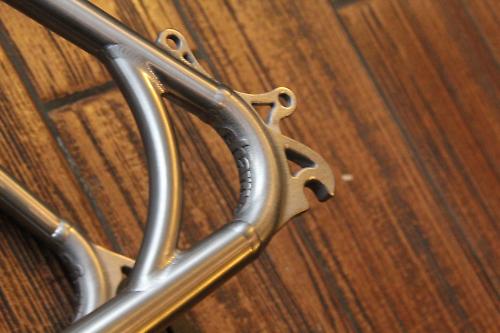- News
- Reviews
- Bikes
- Components
- Bar tape & grips
- Bottom brackets
- Brake & gear cables
- Brake & STI levers
- Brake pads & spares
- Brakes
- Cassettes & freewheels
- Chains
- Chainsets & chainrings
- Derailleurs - front
- Derailleurs - rear
- Forks
- Gear levers & shifters
- Groupsets
- Handlebars & extensions
- Headsets
- Hubs
- Inner tubes
- Pedals
- Quick releases & skewers
- Saddles
- Seatposts
- Stems
- Wheels
- Tyres
- Tubeless valves
- Accessories
- Accessories - misc
- Computer mounts
- Bags
- Bar ends
- Bike bags & cases
- Bottle cages
- Bottles
- Cameras
- Car racks
- Child seats
- Computers
- Glasses
- GPS units
- Helmets
- Lights - front
- Lights - rear
- Lights - sets
- Locks
- Mirrors
- Mudguards
- Racks
- Pumps & CO2 inflators
- Puncture kits
- Reflectives
- Smart watches
- Stands and racks
- Trailers
- Clothing
- Health, fitness and nutrition
- Tools and workshop
- Miscellaneous
- Buyers Guides
- Features
- Forum
- Recommends
- Podcast
news
 Charge Bikes EADS dropout printing - finished dropouts
Charge Bikes EADS dropout printing - finished dropoutsVideo: Charge 3D printed titanium dropouts being made
road.cc had an exclusive first look the 3D printing process being used by Charge Bikes in this video last summer, and today Charge have edited their own video showing how EADS Innovation Works, the corporate research centre for the EADS group, produce the dropouts from a pile of titanium dust. It's fascinating stuff.
In this video, it's Charge'sNick Larsen, takes us around the facility, and chats to Andy Hawkins from EADS about the process and the benefits over traditional fabrication methods. The dropouts in question are being used in Charge's latest titanium cyclo-cross frame, and because of the high cost of the dropouts it's a very limited run, just 50 being initially produced.

3D printing, or additive layer manufacturing to give it the proper name, starts out with a fine layer of titanium powder, on which a precision laser draws an outline, melting the layer. This process is repeated until a 3D object rises magically from the dust. But better than magic because no smoke and mirrors are involved. Very much the coming thing it is (as Yoda might say) so much so that we've got another 3D bike part printing almost done and dusted and coming your way soon.
David worked on the road.cc tech team from 2012-2020. Previously he was editor of Bikemagic.com and before that staff writer at RCUK. He's a seasoned cyclist of all disciplines, from road to mountain biking, touring to cyclo-cross, he only wishes he had time to ride them all. He's mildly competitive, though he'll never admit it, and is a frequent road racer but is too lazy to do really well. He currently resides in the Cotswolds, and you can now find him over on his own YouTube channel David Arthur - Just Ride Bikes.
Latest Comments
- AidanR 8 min 21 sec ago
I came off my bike just before Christmas and broke my femur. The care was excellent and I'm back on the bike, albeit with more rehab to be done.
- mdavidford 24 min 41 sec ago
Untitled, or entitled? I bet it speeds down towpaths and weaves in and out of boats, and it's definitely not wearing a helmet or hi vis.
- Oldfatgit 1 hour 28 min ago
Are these actually 'hi-viz' - or just brights?...
- Bungle_52 1 hour 29 min ago
That one was completely different though, it was a driver not a car as in the other 3. So 1 in 4 of the stories manage to follow reporting guidelines.
- Rendel Harris 3 hours 22 min ago
Absolutely they could have. Tarmac is a petroleum-based product and its surface can be very oily when it's newly laid. This is particularly the...
- ROOTminus1 9 hours 24 min ago
I'm glad the article went into more detail and cleared things up, the headline had me worried that some autonomous building had run rampant and...
- mark1a 9 hours 42 min ago
Still here, just showing a few signs of wear and tear. Hopefully still serviceable for some years to come.
- Rendel Harris 10 hours 27 min ago
How can you know that you are "equally fearful" as "any female cyclist"? There is no possible way of quantifying such emotions and female cyclists...
- chrisonabike 10 hours 59 min ago
I think it would be fairer to blame the moon - as in "my client is a loony".
- Bungle_52 11 hours 22 min ago
Nice idea but Gloucestershire Constabulary are not interested as exemplified by this prvious NMOTD. Not only was there NFA for the close pass in...
Add new comment
2 comments
Surely it is the process - as you can create multiple designs in one print run without having to set multiple different machining tools in process at the same time to produce them? He mentions it at the beginning.
It is just a tube, but where the design improvements come in is being able to produce tricky shapes that are difficult to consistantly produce with molten metal mould processing or cutting. Did I imagine it or have Campag been producing a derailleur arm with 3D printing to reduce weight that can't be achieved with conventional methods?
It may have all sorts of medical and aerospace uses but in many respects with bicycles it's still a solution looking for a problem.
Hmmm more precisely it's SLS (selective laser sintering).
So they're proud of a copying a bent-tube-with-plate dropout design & adding their logo twice? Did their tube bender break?
The skill is not the process (as anybody can send a STL file to somewhere like Shapeways & receive parts exactly like these) but about the design.